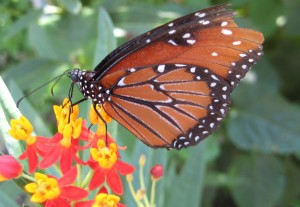In August and September you’ll likely spot monarch butterflies. Much of the Lone Star state is along the migratory pathway of monarch butterflies heading south from Midwest states  to warmer winter weather in Mexico. In fact, the monarch is the Texas state butterfly.
to warmer winter weather in Mexico. In fact, the monarch is the Texas state butterfly.
Few backyard visitors bring more delight than the graceful butterfly. Texas backyard naturalists are fortunate to live in a state with such a wide diversity of butterfly species – 495 in all. Here are some tips for making your garden butterfly friendly.
Gardening for Butterflies. Butterfly gardens are chocked full of colorful flowers. Butterflies like nectar plants with shallow flower tubes, and are attracted to large groupings of red, yellow, orange and purple flowers. Unlike the hummingbird who feeds at the flower while hovering, butterflies require a flower that allows them to land and feed in place. Purple coneflower, butterfly weed, mealy blue sage, phlox and lantana are all native Texas plants that invite butterflies to visit. For the best results, include a wide variety of nectar plants with varied blooming seasons – that way the garden can feed butterflies in spring, summer and fall.
Butterflies also need warm temperatures — between 85 and 100 degrees – to thrive. Ideally, a sunny spot is best for the garden.
The North American Butterfly Association (NABA) publishes a comprehensive list of plants suitable for butterflies in specific regions. Their plant list includes both native and non-native plants, along with information on flower blooming seasons.
Finally, butterflies need a small sandy wet garden spot to puddle. It’s from these sandy or muddy garden spots the butterfly gets the salts and minerals it needs that aren’t in plant nectar.
Gardening for Caterpillars. It takes more than brightly colored flowers and a puddling spot for a successful butterfly garden.
Like all insects, butterflies undergo metamorphosis, changing from egg, to larvae (caterpillar), to pupae (chrysalis) to adult (beautiful butterfly). Accommodating all phases of the butterfly life cycle keeps butterflies in the garden. And while adult butterflies feed on a variety of nectar producing flowers, they lay eggs only on select host plants. Some butterflies, like monarchs, lay eggs only on a single variety of plant.
Adult butterflies know which plants are suitable by taste. The adult butterfly tastes the plant with its feet. Yes, that’s right, the adult butterfly lands on a host plant and through its feet determines if the plant is correct for its eggs.
To encourage butterflies to lay their eggs in your garden, consider planting milkweed (monarch), dill and parsley (swallowtail), passion vine (fritillary) or thistle (painted lady). Caterpillars have their own special beauty with colorful bandings. These voracious eaters can munch a plant down to its stem, but rarely does this kill the host plant.
If you want butterfly caterpillars, do not use any pesticides near your larval host plants as these will kill the caterpillars.

